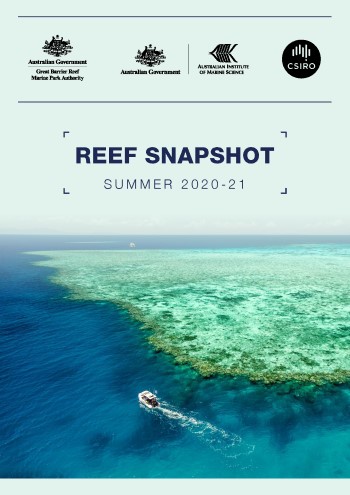The annual Reef snapshot: summer 2020-21 has been released today by the Great Barrier Reef Marine Park Authority, Australian Institute of Marine Science (AIMS), and CSIRO.
The snapshot, now in its second year, is a summary of recent summer conditions and coral ‘health’ for different regions of the Reef. It sets the scene for more detailed reports to be released later in 2021, including AIMS’ Annual Summary Report on Coral Reef Condition, based on surveys conducted by AIMS’ Long-term Monitoring Program.
AIMS’ CEO Dr Paul Hardisty said the snapshot reflected a unified view from the three Australian Government agencies.
“Through this joint approach we each contribute different capabilities and apply the best available knowledge to ensure a healthy ecosystem for future generations,” Dr Hardisty said.
“As the nation’s tropical marine science agency, AIMS brings a range of scientific expertise, including long-term understanding of how disturbances affect the cycles of coral decline and recovery.
“This knowledge helps the Marine Park Authority with its ongoing reef management and enables both AIMS and CSIRO to protect coral reefs through reef adaptation and restoration science.”
This year, mild conditions during the recent summer months provided an opportunity for recovery for Australia’s best-loved natural icon, the Great Barrier Reef.
Great Barrier Reef Marine Park Authority Chief Executive Officer Josh Thomas said conditions this summer were relatively uneventful, in a positive way.
“The 2020-21 summer months were unlike the intense summer periods we have seen over some of the last few years which had mass bleaching and extreme weather — so this is good news for the Reef,” he said.
“It is very important to put this into context — while conditions certainly provided relief for much of the Reef, this does not mean it is out of the woods as it has experienced a variety of disturbances over the past decade, and global action on climate change remains critical.
“In-water actions, compliance with zoning rules, crown-of-thorns starfish control, and other Reef interventions are all key in the mix that will give the Reef the best outlook in the long-term. It’s important we don’t take our foot off the pedal.”
Among the findings from the 2020-21 summer:
- There were no prolonged high temperature or major cyclone disturbances, and many reefs continued their recovery from past impacts.
- Water temperatures did not cause as much coral heat stress as recent years, although all months were warmer than average.
- Cyclone Kimi was the only tropical cyclone that tracked across the Reef, and its potential to cause widespread catastrophic damage to reefs was assessed as very low.
- While there was some good rainfall in the catchment, flood levels in waterways near the Reef were generally not major or sustained.
- Crown-of-thorns starfish remain at outbreak or potential outbreak levels in parts of the northern, central and (particularly) southern regions of the Reef. The Crown-of-thorns Starfish Control Program continues to work in all three regions to cull starfish down to non-outbreak levels.
Dr Peter Mayfield the Executive Director of Environment, Energy and Resources for CSIRO — Australia’s national science agency — acknowledged the Reef was home to a wealth of marine biodiversity unmatched anywhere in the world.
“This international icon is being challenged from human activities both locally and globally, so understanding how we can help restore and adapt the Reef requires the best information and collaborative science,” said Dr Mayfield.
“This snapshot helps inform us all, as we all have a stake in ensuring the Reef’s future.”
The snapshot is available at www.gbrmpa.gov.au


